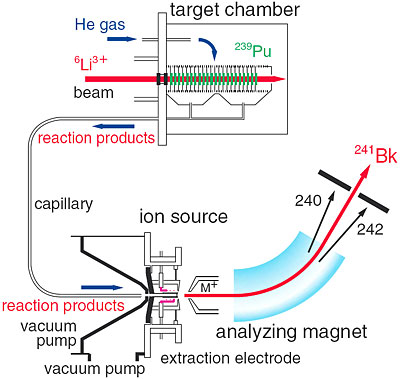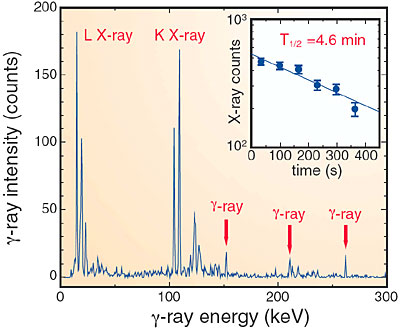Nuclei are composed of protons and neutrons. The structure of nuclei varies gradually with the number of protons and neutrons, and sometimes it shows sudden changes. About 250 nuclides exist in nature, and more than 2500 nuclides have been produced artificially up to now. However, thousands of nuclides remain to be discovered. Exploration of those unknown nuclides will reveal new properties of nuclear structure.
Nuclei with a proton number greater than 90 show an increasing instability owing to Coulomb repulsion between the protons and exhibit various interesting properties such as spontaneous fission and exotic deformation. To investigate nuclear structure, one has to generate nuclei of interest and measure, e.g., gamma-rays and alpha particles emitted from these nuclei. However, since production cross sections of heavy nuclei are extremely small, other reaction products produced simultaneously prevent us from observing gamma-rays from heavy nuclei. In particular, it is quite difficult to observe nuclei with a half-life shorter than 10 min and a small alpha-decay probability.
In order to overcome these difficulties, we have developed a gas-jet coupled on-line isotope separator (Fig. 7-1). Heavy nuclei are produced by bombarding U or Pu targets with a 6Li beam. Reaction products are transported into the ion source region of the isotope separator through a capillary by a gas-jet stream (Fig. 7-1), and mass-separated within a few seconds. Since selected nuclei of interest are rapidly separated from other reaction products, weak gamma-rays from nuclei with small production cross sections and short half-lives can be detected very sensitively.
Using this system, we have succeeded in observing the previously unknown isotope 241Bk. In the mass-241 fraction, we have detected the very weak X-rays and gamma-rays associated with the electron capture (EC) decay of 241Bk as shown in Fig.7-2. The half-life of 241Bk was determined to be 4.6 min from the decay curve of the observed X-rays. A few attempts to search for 241Bk had been done using chemical separation techniques, but they failed, because its half-life is much shorter than the separation time and because the chemical separation process cannot distinguish 241Bk from other Bk isotopes such as 242Bk. The observation of the gamma transitions gave us information on the structure of 241Bk and its daughter nucleus. Using this system, we have succeeded in observing not only Bk isotopes, but also many Am and Cm isotopes with half-lives shorter than 10 min. This study has been successful in elucidating the nuclear structure of heavy elements.
|

